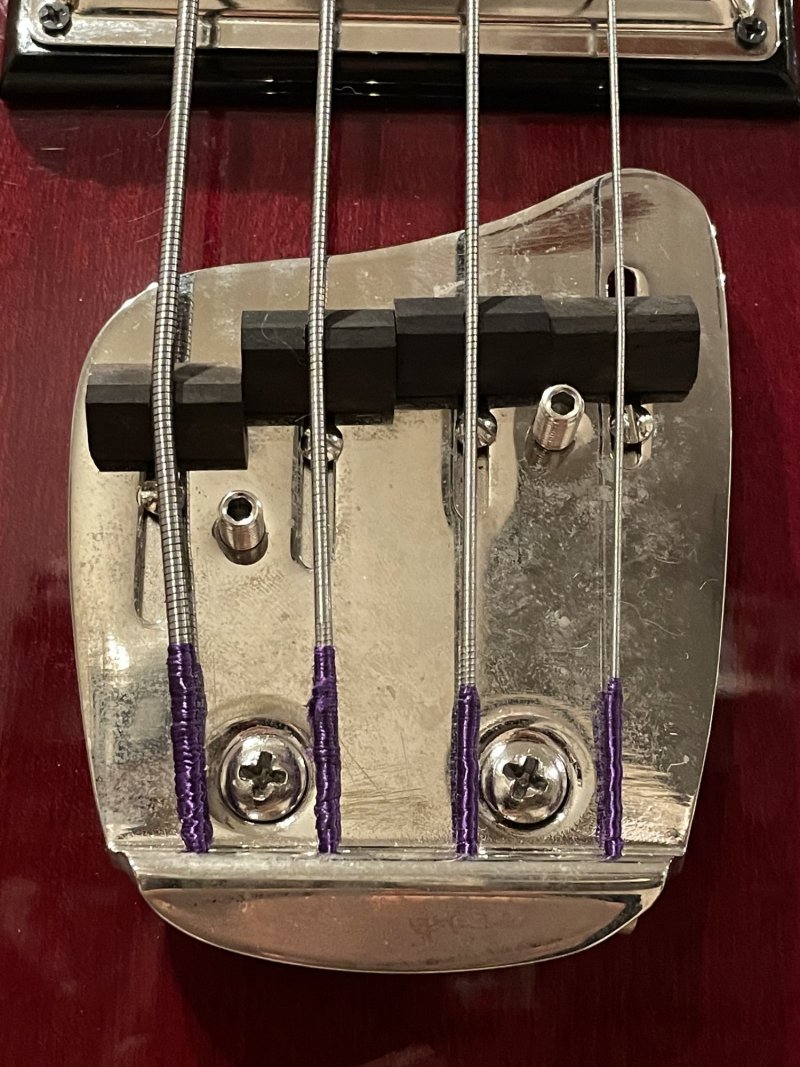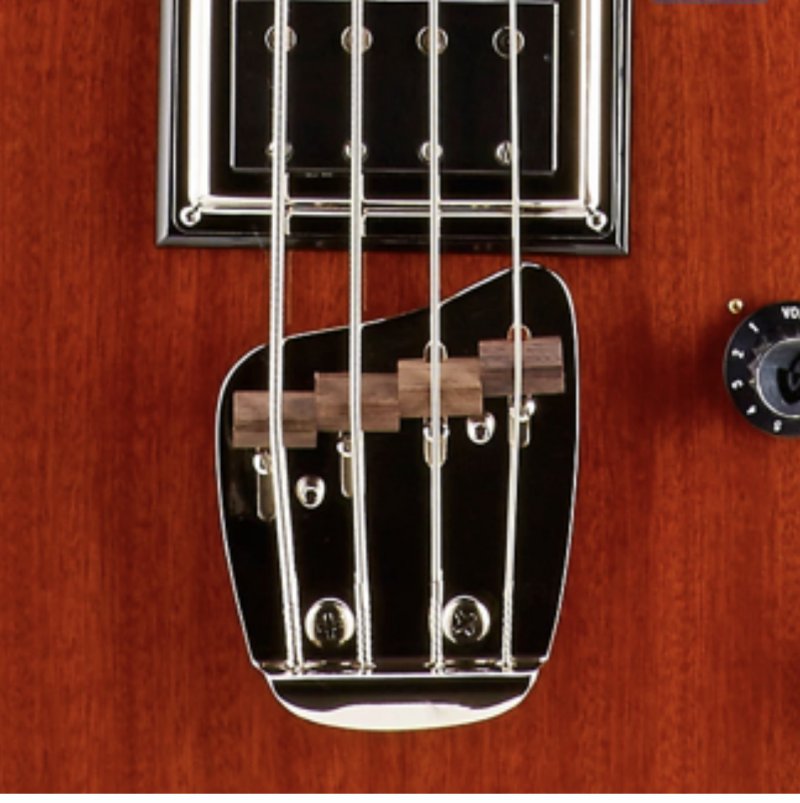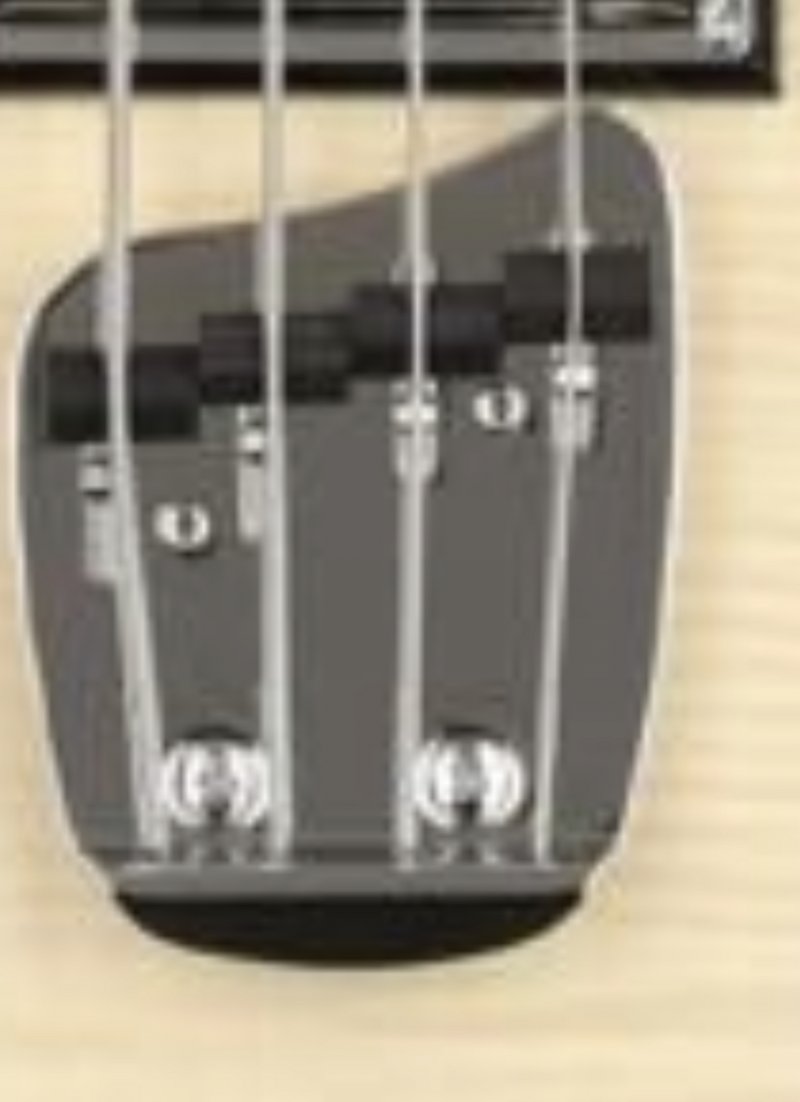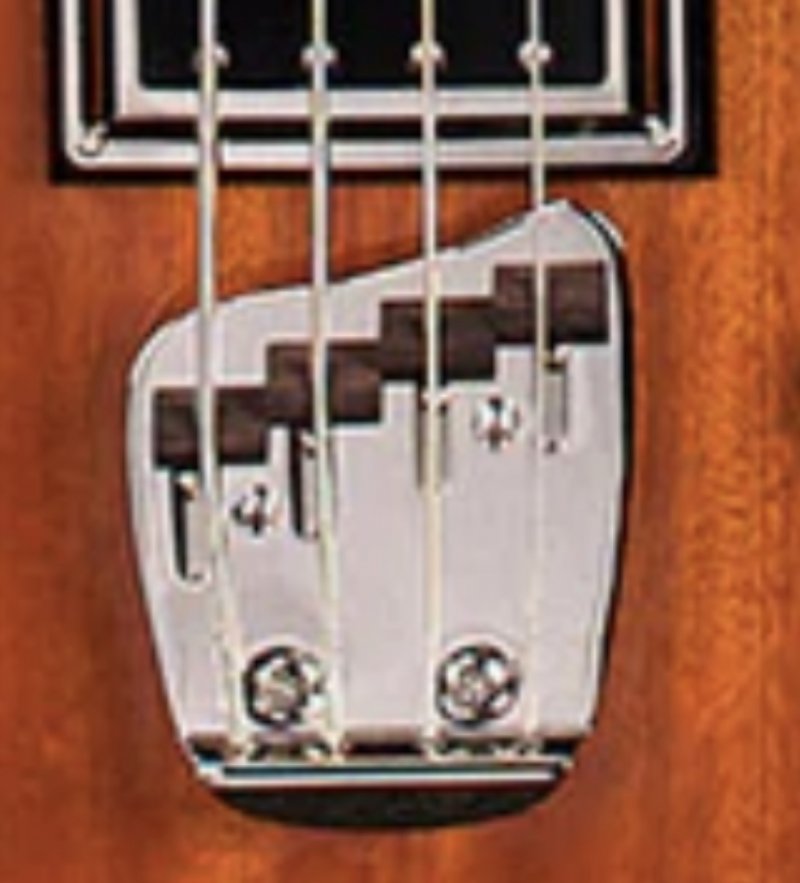You are using an out of date browser. It may not display this or other websites correctly.
You should upgrade or use an alternative browser.
You should upgrade or use an alternative browser.
Starfire bridge setup question.
- Thread starter lungimsam
- Start date
nmiller
Member
Absolutely. That's the main reason there's separate adjustment screws for each side.
fronobulax
Bassist, GAD and the Hot Mess Mods
- Joined
- May 3, 2007
- Messages
- 24,756
- Reaction score
- 8,889
- Location
- Central Virginia, USA
- Guild Total
- 5
Yes. It is designed to tilt.
Of course since the instrument exists for your pleasure if you choose to leave the bridge level and accept the results that is your decision
Of course since the instrument exists for your pleasure if you choose to leave the bridge level and accept the results that is your decision
mellowgerman
Senior Member
Yup, mine have always been set up with a bit of a tilt, a bit higher on the E side.
lungimsam
Senior Member
- Joined
- Oct 1, 2011
- Messages
- 2,619
- Reaction score
- 1,674
- Guild Total
- 2
Thanks.
I neglected to mention I don't mean only action screws but also the rear screws to tilt the back of the plate too (string ball ends end of the tailpiece).
Mine has always been tilted but only makes the g string 1/64 lower. I am thinking of dropping the g side considerably, like so much I will also have to tilt the back (foam) end of the tailpiece.
I neglected to mention I don't mean only action screws but also the rear screws to tilt the back of the plate too (string ball ends end of the tailpiece).
Mine has always been tilted but only makes the g string 1/64 lower. I am thinking of dropping the g side considerably, like so much I will also have to tilt the back (foam) end of the tailpiece.
Last edited:
fronobulax
Bassist, GAD and the Hot Mess Mods
- Joined
- May 3, 2007
- Messages
- 24,756
- Reaction score
- 8,889
- Location
- Central Virginia, USA
- Guild Total
- 5
I have never adjusted the rear screws. Never had a reason to do so. IIRC there is a fixed plate on the body and a flexible grommet between the fixed plate and the bridge plate. So you could screw one side or the other down until the grommet won't compress anymore.
I have run into an issue with similar setups, but not a Guild bridge. Screwing down one side can raise up the other side and the result will be wobbly because the grommet is no longer compressed enough to stabilize things. Will that happen on a bridge? Dunno, but I would watch for it.
It goes without saying that you will probably have to re-tweak things when you change strings but that could be decades down the road.
I have run into an issue with similar setups, but not a Guild bridge. Screwing down one side can raise up the other side and the result will be wobbly because the grommet is no longer compressed enough to stabilize things. Will that happen on a bridge? Dunno, but I would watch for it.
It goes without saying that you will probably have to re-tweak things when you change strings but that could be decades down the road.
nmiller
Member
The rear screws control the break angle over the saddles. On an electric instrument, most people don't care about break angle as long as the strings don't pop out of their slots and they don't get buzzing. But it does have a small effect on how the strings feel and may also have a small effect on sustain.
nmiller
Member
In theory, a higher break angle means more force from the strings onto the saddles, so a better physical connection and maybe more sustain. In theory. Maybe. The difference is usually pretty audible on an acoustic instrument, but on an electric it may be negligable.
Maybe.
Maybe.
mellowgerman
Senior Member
I have also heard the argument recently from somebody with an engineering background that resonance and sustain (two concepts that I had long assumed to be complementary to each other) might actually be opposing in some ways. The idea being that in order for a string to sustain for a maximum amount of time, you would actually want it to be separate from the resonance of a bass neck and body -- in the sense that the string is more perfectly/consistently constructed than the organic and inherently imperfect wood. So if no outside force is hindering or dampening the string, it will ring for a maximum amount of time. The natural resonant qualities of any piece of wood are imperfect, so once those resonances start pulsing, they will affect and interfere with the string's closer-to-perfect vibration. That's not to say that a high mass metal bridge won't improve sustain, maybe even the exact opposite. If you take an Alembic bridge for example, that brass bridge is anchored in a big brass block that is sunken into the body. That brass block could actually be serving to even-out/disperse/decrease the amount of wood resonance interfering with the vibration of the string, while simultaneously giving the string the most solid, but resonantly-neutral anchor point possible.
I do not have an engineering or physics background and this is me paraphrasing so I hope I'm doing this idea a disservice. The gist of the concept is just that vibration transfer from string to body is actually detrimental to sustain. That said, resonance transfer from string to body is not necessarily a bad thing as it can enhance certain frequencies, making the notes rounder, boomier, etc. (but simultaneously decreasing the amount of sustain). Think about the big booming, resonant, warm tone of an upright... but then think about the sustain of an upright. Also, consider that Alembic makes multi-laminate necks, specifically to make the neck stiffer/sturdier (going back to creating a solid anchor/host surface for the string), but also to interrupt the individual resonant qualities of each piece of wood, which minimizes the wolf-notes and dead-spots characteristic in a solid 1-piece maple neck design like we see on Fenders for example.
So high mass may increase sustain, but not because of contact to the body, simply because it's a very non-resonant barrier between the imperfect wood and the near-perfect string.
I do not have an engineering or physics background and this is me paraphrasing so I hope I'm doing this idea a disservice. The gist of the concept is just that vibration transfer from string to body is actually detrimental to sustain. That said, resonance transfer from string to body is not necessarily a bad thing as it can enhance certain frequencies, making the notes rounder, boomier, etc. (but simultaneously decreasing the amount of sustain). Think about the big booming, resonant, warm tone of an upright... but then think about the sustain of an upright. Also, consider that Alembic makes multi-laminate necks, specifically to make the neck stiffer/sturdier (going back to creating a solid anchor/host surface for the string), but also to interrupt the individual resonant qualities of each piece of wood, which minimizes the wolf-notes and dead-spots characteristic in a solid 1-piece maple neck design like we see on Fenders for example.
So high mass may increase sustain, but not because of contact to the body, simply because it's a very non-resonant barrier between the imperfect wood and the near-perfect string.
Last edited:
lungimsam
Senior Member
- Joined
- Oct 1, 2011
- Messages
- 2,619
- Reaction score
- 1,674
- Guild Total
- 2
Interesting points.
What would be really cool is to replace my bridge with an original hagstrom '60's starfire bridge to get the strings centered over the neck without having the saddles constantly pulled with sideways force by the strings (when strings centered over neck) like the NS harp shaped NS tailpieces require if one is to center the strings on the neck. I wonder what effect that is having on tone, if any.
It is interesting to note that I always thought of bridges that don;t contact the face of the instrument (Gibson 3 point - etc) would "scatter" the sound but that is an interesting point that they might seperate the string resonance from the bass body resonance. Very interesting.
What would be really cool is to replace my bridge with an original hagstrom '60's starfire bridge to get the strings centered over the neck without having the saddles constantly pulled with sideways force by the strings (when strings centered over neck) like the NS harp shaped NS tailpieces require if one is to center the strings on the neck. I wonder what effect that is having on tone, if any.
It is interesting to note that I always thought of bridges that don;t contact the face of the instrument (Gibson 3 point - etc) would "scatter" the sound but that is an interesting point that they might seperate the string resonance from the bass body resonance. Very interesting.
Last edited:
fronobulax
Bassist, GAD and the Hot Mess Mods
- Joined
- May 3, 2007
- Messages
- 24,756
- Reaction score
- 8,889
- Location
- Central Virginia, USA
- Guild Total
- 5
Interesting points.
What would be really cool is to replace my bridge with an original hagstrom '60's starfire bridge to get the strings centered over the neck without having the saddles constantly pulled with sideways force by the strings (when strings centered over neck) like the NS harp shaped NS tailpieces require if one is to center the strings on the neck. I wonder what effect that is having on tone, if any.
It is interesting to note that I always thought of bridges that don;t contact the face of the instrument (Gibson 3 point - etc) would "scatter" the sound but that is an interesting point that they might seperate the string resonance from the bass body resonance. Very interesting.
I do not know why you think an original bridge would be less prone to having the saddles pulled sideways. That happens on all of my Guild bridges ('67, '71 and '13). Being lazy when changing strings or intonation is one time it happens. Aggressive fingerpicking is another. Since I try not to do the former and avoid doing the latter for aesthetic reasons it's not a problem for me.
lungimsam
Senior Member
- Joined
- Oct 1, 2011
- Messages
- 2,619
- Reaction score
- 1,674
- Guild Total
- 2
Cuz look. You can see the 65 is straight alignment vs. NS which has the sideways pull of the low E . That’s where they have to be to achieve straight alignment. But if you say it still happens on a square tailpiece, I’ll take your word for it and save myself the trouble of looking for one.
Attachments
-
 A8BCDAC5-6AD6-4DE8-99DF-7FBFBDF6D00F.jpeg1.2 MB · Views: 85
A8BCDAC5-6AD6-4DE8-99DF-7FBFBDF6D00F.jpeg1.2 MB · Views: 85 -
 A217E079-DB19-401C-A2D2-81E7A8838819.jpeg506 KB · Views: 87
A217E079-DB19-401C-A2D2-81E7A8838819.jpeg506 KB · Views: 87 -
 F4E0E3C2-CCBC-406C-84B2-5A1766006AF4.jpeg926.6 KB · Views: 93
F4E0E3C2-CCBC-406C-84B2-5A1766006AF4.jpeg926.6 KB · Views: 93 -
 34817A9C-B889-409C-8382-41AD51D37014.jpeg808.6 KB · Views: 90
34817A9C-B889-409C-8382-41AD51D37014.jpeg808.6 KB · Views: 90 -
 35FAD81A-1F45-4D2E-9924-E67FF6487ED0.jpeg890.8 KB · Views: 86
35FAD81A-1F45-4D2E-9924-E67FF6487ED0.jpeg890.8 KB · Views: 86
Last edited:
fronobulax
Bassist, GAD and the Hot Mess Mods
- Joined
- May 3, 2007
- Messages
- 24,756
- Reaction score
- 8,889
- Location
- Central Virginia, USA
- Guild Total
- 5
Mine all look more like the right. The '65 could be because the black plastic saddles are not the same dimensions as the later rosewood saddles (rather than some bridge dimension changing). If it bothered me I try "shaving" some saddles.
lungimsam
Senior Member
- Joined
- Oct 1, 2011
- Messages
- 2,619
- Reaction score
- 1,674
- Guild Total
- 2
The strings must be that bent (saddles slid that far over) for straight alignment o’er the neck with use of the harp because the ball end holes are too far to the lower bout side of their respective intonation slots on the harps. The 65 has all its ball end holes centered better in relation to the paddle slots better on the tailpiece. So I guess you don’t need to slide them over for good alignment. The harp is not a deal breaker on the bass but it’d be nice to not have to keep sliding them back sometimes so I don’t fall off the neck playing the g string. Though the saddles stick pretty good once set.
Last edited:
mellowgerman
Senior Member
What if you drilled a little hole straight through the G string saddle (just left of the paddle if looking at the bridge like the photos above) and slid a little piece of wire in there? That should keep the saddles from sliding off-center.
I will say that I never had an issue with the saddles sliding side-to-side once under tension, regardless of whether it was a harp style bridge or the original straight-front Hagstrom bridge.
The only issue I encountered was that the saddles were slotted somewhat unevenly on one of my vintage harp bridges (can't remember which it was), so I put little black plastic spacers in-between them as necessary to get the strings to fall in place over the pickup poles and evenly the neck.
I will say that I never had an issue with the saddles sliding side-to-side once under tension, regardless of whether it was a harp style bridge or the original straight-front Hagstrom bridge.
The only issue I encountered was that the saddles were slotted somewhat unevenly on one of my vintage harp bridges (can't remember which it was), so I put little black plastic spacers in-between them as necessary to get the strings to fall in place over the pickup poles and evenly the neck.
Happy Face
Justified Ancient of MuMu
- Joined
- Dec 11, 2007
- Messages
- 921
- Reaction score
- 244
What if you drilled a little hole straight through the G string saddle (just left of the paddle if looking at the bridge like the photos above) and slid a little piece of wire in there? That should keep the saddles from sliding off-center.
I will say that I never had an issue with the saddles sliding side-to-side once under tension, regardless of whether it was a harp style bridge or the original straight-front Hagstrom bridge.
The only issue I encountered was that the saddles were slotted somewhat unevenly on one of my vintage harp bridges (can't remember which it was), so I put little black plastic spacers in-between them as necessary to get the strings to fall in place over the pickup poles and evenly the neck.
Plastic spacers. Ever the perfectionist! I used to employ index card material and even paper clips.
But I never noticed any tonal variation as a result so I took them out. But you guys hv better ears than I.
fronobulax
Bassist, GAD and the Hot Mess Mods
- Joined
- May 3, 2007
- Messages
- 24,756
- Reaction score
- 8,889
- Location
- Central Virginia, USA
- Guild Total
- 5
I admit I waffle back and forth between disparaging your obsessions and trying to help you achieve your goal.
In the spirit of the latter, lets look at this as an exercise in geometry. By physics and definition the string is always going to be straight between two points, while it is under tension. So the issue is whether strings are parallel to each other or perpendicular to some other component. Note also the opportunity for optical illusions because the strings can appear parallel when they are not so a measurement is always better than the Mark I eyeball.
First we have the string between the nut and the bridge saddles. To be parallel the distance between any two strings needs to be the same whether measured at the nut, the saddle or just somewhere along the speaking length. If the distance between the saddle slots is not identical to the distance between the slots on the nut (somehow saying "nut slots" just seemed wrong) then the strings will never be parallel and "straight" is a subjective judgement based upon appearance, not measurement. (As an aside the strings should be perpendicular to the frets or else the instrument has been badly assembled and the distance between the center of pole pieces must be the same as the distances between the various slots or things will never line up).
Of less importance is the area between where the strings are anchored to the bridge and the saddles. Again the spacing between the saddle slots and the anchor holes needs to be identical or the strings will not be parallel. The travel slots for the saddles should be perpendicular to the saddle slot. If we accept that there will never be straightness behind the saddles then the slots should be parallel to the "continuation" of the string as it could continue over the saddles.
So there are a couple of measurements that could easily prove that the quest for straightness is physically and objectively impossible and a claim of straightness is at best subjective.
Having said all of that there are definitely players who prefer a "fan" at the bridge so that the strings are not parallel. The preference is driven by playing technique and not tone.
Having misaligned the saddles I have found that making the E string as straight as possible over the saddle and thereby shifting all of the other strings to the G side does not make a difference in tone or sustain that I can hear. It does make things feel different for my plucking hand and it bothers me every time I look at it so there is motivation to shift things back to the E side and "fix" things.
Of all the things that could be done to change subjective straightness in the quest for an observable change in "playing" or tone, the most likely one would be to adjust the saddles so that the slot spacing is the same as the nut and the slot is parallel to the string.
In the spirit of the latter, lets look at this as an exercise in geometry. By physics and definition the string is always going to be straight between two points, while it is under tension. So the issue is whether strings are parallel to each other or perpendicular to some other component. Note also the opportunity for optical illusions because the strings can appear parallel when they are not so a measurement is always better than the Mark I eyeball.
First we have the string between the nut and the bridge saddles. To be parallel the distance between any two strings needs to be the same whether measured at the nut, the saddle or just somewhere along the speaking length. If the distance between the saddle slots is not identical to the distance between the slots on the nut (somehow saying "nut slots" just seemed wrong) then the strings will never be parallel and "straight" is a subjective judgement based upon appearance, not measurement. (As an aside the strings should be perpendicular to the frets or else the instrument has been badly assembled and the distance between the center of pole pieces must be the same as the distances between the various slots or things will never line up).
Of less importance is the area between where the strings are anchored to the bridge and the saddles. Again the spacing between the saddle slots and the anchor holes needs to be identical or the strings will not be parallel. The travel slots for the saddles should be perpendicular to the saddle slot. If we accept that there will never be straightness behind the saddles then the slots should be parallel to the "continuation" of the string as it could continue over the saddles.
So there are a couple of measurements that could easily prove that the quest for straightness is physically and objectively impossible and a claim of straightness is at best subjective.
Having said all of that there are definitely players who prefer a "fan" at the bridge so that the strings are not parallel. The preference is driven by playing technique and not tone.
Having misaligned the saddles I have found that making the E string as straight as possible over the saddle and thereby shifting all of the other strings to the G side does not make a difference in tone or sustain that I can hear. It does make things feel different for my plucking hand and it bothers me every time I look at it so there is motivation to shift things back to the E side and "fix" things.
Of all the things that could be done to change subjective straightness in the quest for an observable change in "playing" or tone, the most likely one would be to adjust the saddles so that the slot spacing is the same as the nut and the slot is parallel to the string.